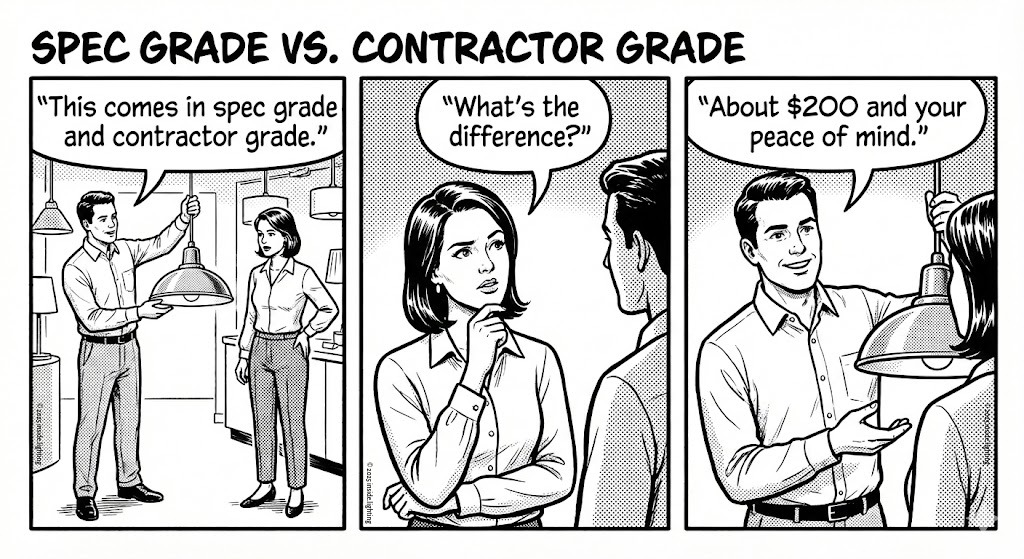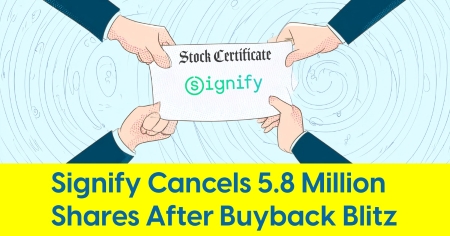February 8, 2025
5 Things to Know: February 8

Hubbell discloses financial losses tied to lighting divestiture. Plus, three new lighting lawsuits were just filed.
Here's a roundup of some of the week's happenings curated to help lighting people stay informed.
1. Hubbell Reports Financial Impact of Progress Lighting Sale
Hubbell Inc. has disclosed new financial details regarding its 2024 divestiture of Progress Lighting, its former residential lighting brand, according to its latest 8-K filing. The company reported a $5.3 million pre-tax accounting loss from the sale, alongside a $6.8 million income tax expense, primarily due to differences in the book and tax basis of goodwill. The sale, completed in early 2024, was part of Hubbell’s strategic exit from the lighting sector, following its earlier divestment of its commercial and industrial lighting business.
Progress Lighting was sold to Kingswood Capital Management, a private equity firm based in Los Angeles, in a $131 million all-cash transaction. The brand generated approximately $187.1 million in revenue in 2023 and was a key part of Hubbell’s Electrical Solutions segment. The sale contributed to an 8% decline in the segment’s net sales in Q4 2024 compared to the previous year, with overall net sales dropping from $534 million to $487 million.
With the completion of this transaction, Hubbell has largely exited the lighting industry, refocusing on its core utility and electrical solutions business. The company retains ownership of Chalmit Lighting, a Scotland-based brand specializing in LED solutions for hazardous environments. Meanwhile, Kingswood Capital Management adds Progress Lighting to its growing portfolio, which now also includes Kichler Lighting.
2 . Three New Patent Lawsuits Just Filed
ETC vs. Elation Lighting
Electronic Theatre Controls Inc. (ETC) has filed a patent infringement lawsuit against Elation Lighting Inc. in the U.S. District Court for the Central District of California. The complaint alleges that Elation infringed on three ETC-owned patents—U.S. Patent Nos. 8,593,074, 11,240,898, and 11,849,519—through the sale and distribution of its Fuze Teatro light fixture. ETC claims that Elation had both actual and constructive knowledge of the patents and that the infringement is willful. The lawsuit seeks damages, an injunction to prevent further infringement, and enhanced compensation under U.S. patent law.
AGS Lighting vs. Jesco Lighting
AGS Lighting Management has filed a patent infringement lawsuit against Jesco Lighting Group in the U.S. District Court for the District of Delaware. The complaint alleges that Jesco's LIN SLIM modular linear lighting fixtures infringe AGS Lighting’s U.S. Patent No. 11,751,302, which covers technology for adjustable color temperature and brightness in LED fixtures. AGS claims that Jesco has been aware of the patent and continues to sell the accused products despite prior notice. The lawsuit seeks damages, an injunction to prevent further infringement, and enhanced compensation under U.S. patent law.
Lime Green Lighting vs. Brilliant NextGen
Lime Green Lighting has filed a patent infringement lawsuit against Brilliant NextGen Inc. in the U.S. District Court for the Northern District of California. The complaint alleges that Brilliant NextGen’s products infringe on U.S. Patent No. 9,699,874, which covers LED lighting integrated with electric fans. Lime Green Lighting claims that Brilliant NextGen has knowingly encouraged customers to use its products in a way that infringes the patent. The lawsuit seeks damages, an injunction to halt further infringement, and potential enhanced compensation under U.S. patent law.
Weeks ago, Lime Green Lighting filed two additional lawsuits—one against Nanoleaf and another against Savant Systems, which owns the GE Lighting residential lamp business. Notably, the lawsuit against Savant was voluntarily dismissed just 10 days after it was filed.
3. Largescale UV Light Disinfection Pilot
Patch reports that the Swampscott Select Board in Massachusetts is evaluating a $400,000 investment in a UV light treatment pilot program aimed at making King’s Beach swimmable again. While the lighting industry has long explored UV disinfection for single-room indoor spaces, this initiative represents a large-scale application designed to treat an entire body of water. The proposed three-month pilot, shared with the city of Lynn, would install the temporary UV system on Humphrey Street this summer. However, Select Board members raised concerns about cost-sharing fairness, long-term expenses, and the feasibility of scaling the project if successful.
With a full-scale UV treatment estimated to cost at least $25 million over 20 years, Patch reports that officials are weighing the benefits of testing the technology this summer before committing to a long-term solution. The Select Board will revisit the proposal in two weeks, seeking more clarity on cost-sharing and implementation before making a final decision.
Unrelated, Swampscott and Lynn have a combined total of eight Dunkin’ stores, half of which feature drive-thru service.
4. WSJ Editorial Highlights Ongoing Debate Over LED
The lighting industry is keen to watch how mainstream media and everyday consumers perceive lighting, as these opinions influence commercial lighting decisions and occupant preferences in buildings.
A recent Wall Street Journal editorial, Confessions of a Lightbulb Hoarder, highlights lingering resistance to LED technology following the U.S. ban on incandescent bulbs in 2023. The article’s author recounts panic-buying 1,000 incandescent bulbs to preserve the warm, rich glow that LEDs often struggle to replicate. Lighting designer Sara McElroy explains that incandescents produce full-spectrum light, offering subtle illumination and softer shadows compared to the narrower spectrum of many LEDs. However, she notes that well-designed LEDs, such as those from Philips, Soraa, and Tala, can provide more appealing warmth, especially when dimmable.
The article also highlights some unconventional ways to make LEDs feel more like incandescents:
- Go for pink silk: Brittnee Ulmer of Bevolo Gas & Electric Lights suggests wrapping LED bulbs in pink silk threads to create a flattering amber glow.
- Skip “daylight” LEDs: Designer Karen Spector warns against ultra-bright “daylight” LEDs, recommending dimmable bulbs with color temperatures of 2700 Kelvin or lower for a golden-hour softness.
- Decorative LED upgrades: The WSJ piece highlights Tala’s “porcelain” line of frosted LED bulbs, which mimic the warm aesthetic of classic incandescents.
- DIY nail polish trick: Spector has even coated LED bulbs with nail polish to improve luminescence—Essie’s “Apricot Jelly” is her go-to shade.
These quirky solutions reflect the continued struggle some consumers employ to replicate the cozy, inviting glow of traditional lighting in an era increasingly dominated by LEDs.
5. Fluxwerx Expands to Middle East
Fluxwerx Illumination is expanding into the Middle East, marking its second major overseas move following its 2024 launch in Europe. The Canadian architectural lighting company, part of LMPG Inc., first entered global markets by introducing its luminaires in the United Kingdom, Sweden, France, and Italy, leveraging Lumenpulse’s established sales network there and partnering with local firms to meet regional standards.
Now, Fluxwerx is bringing its minimalist lighting solutions to the Middle East through a partnership with Dubai-based MSF Lighting, a company with over 30 years of experience in the region. The expansion aligns with Fluxwerx’s strategy to extend its reach into new markets, building on LMPG’s history of international growth, including its long-standing presence in the UK and Asia.










